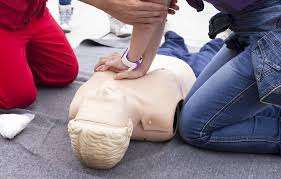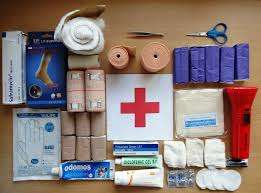First Aid in the workplace
First aid is the initial emergency care given immediately upon arrival at the scene to an ill or injured person. The first aider and people who are assisting should continue with assistance until the professional medical assistance takes over the care of the casualty. Medical professionals may include paramedics, doctors, or ambulance officers. 
Although there are 3 original P’s, we will also include two more areas that needs attention when conducting primary emergency care.
These are as follows:
Protection against further injury.
Preservation of life.
Promotion of recovery.
Prevention of injuries for people at any age.
Promotion of healthy lifestyles.
Above are now discussed:
Protection against further injury
No injured person should be moved if his or her life is in danger. If a person is not breathing and has no pulse, his or her life is in danger. Life threatening situations exist where there is significant risk of loss of life.
Knowing what to do in an emergency is as important as knowing what not to do. Moving a person with a neck injury, for example, can lead to permanent spinal cord injury and paralysis.
In spite of the variety of injuries possible, several principles of first aid apply to all emergencies. The very first step is to call for professional medical help, if that is possible. Establish what dangers may still be present at the scene of the accident or injury before beginning to provide first aid.
Preservation of life
In order to stay alive, all persons need to have an open airway, a clear passage where air can move in through the mouth or nose through the pharynx (part of the throat) and down in to the lungs, without obstruction.
Conscious people will maintain their own airway automatically, but those who are unconscious may be unable to maintain a patent airway, as the part of the brain which automatically controls breathing in normal situations may not be functioning.
If the patient was breathing, a first aider would normally then place them in the recovery position, with the patient leant over on their side, which also has the effect of clearing the tongue from the pharynx.
It also avoids a common cause of death in unconscious patients, which is choking on regurgitated stomach contents. The airway can also become blocked through a foreign object becoming lodged in the pharynx or larynx, commonly called choking.
The first aider will be taught to deal with this through a combination of ‘back slaps’ and ‘abdominal thrusts’.
Once the airway has been opened, the first aider would assess to see if the patient is breathing. If there is no breathing, or the patient is not breathing normally, such as agonal breathing (abnormal pattern of breathing), the first aider would undertake what is probably the most recognised first aid procedure, called cardiopulmonary resuscitation or CPR, which involves breathing for the patient, and manually massaging the heart to promote blood flow around the body.
Promoting Recovery
The first aider is also likely to be trained in dealing with injuries such as cuts, grazes or bone fracture. They may be able to deal with the situation in its entirety (a small adhesive bandage on a paper cut), or may be required to maintain the condition of something like a broken bone, until the next stage of definitive care (usually an ambulance) arrives.
Prevention of injuries for people of all ages
The first aider must prevent injuries for all age groups. Age groups are categorised as follows:
Infant: For purposes of first aid, an infant is defined as being younger than 1 year of age.
Child: A child is categorised as being above 1 year of age
Adult: For purposes of first aid, adults are defined as people about age 12 (adolescents) or older.
You need parental permission to give care to a child or an infant, even if it is an emergency. The only reasons for which you could give care without permission are if the parent is not present or is injured and unable to respond.
Promoting of Healthy Lifestyles
The upside to living healthy is that there are many different ways to go about doing it. So many ways that there is no reason why you can't find a plan which suits you well. But no matter which way you decide works best for you, here are some general guidelines you are probably going to want to adhere to:
Be a role model.
Encourage healthy eating
Encourage physical activity.
There needs to be one first aider for every 50 employees, and this person (or their substitute) must be available at very short notice during working hours. There should be a roster drawn up, with duties allocated (as well as substitutes should the primary first aider be absent).
In every first aid box there are a set of minimum contents.
Wound cleaner / antiseptic (100ml)
Swabs for cleaning wounds
Cotton wool for padding (100g)
Sterile gauze (minimum quantity 10)
1 pair of forceps (for splinters)
1 pair of scissors (minimum size 100mm)
1 set of safety pins
4 triangular bandages
4 roller bandages (75mm x 5m)
4 roller bandages (100mm x 5m)
1 roll of elastic adhesive (25mm x 3m)
1 Non-allergenic adhesive strip (25mm x 3m)
1 Packet of adhesive dressing strips (minimum quantity 10 assorted sizes)
4 First aid dressings (75mm x 100mm)
4 First aid dressings (150mm x 200mm)
2 Straight splints
2 Pairs large and 2 pairs medium disposable latex gloves
2 CPR mouth pieces or similar devices
An adequate supply of absorbent material for the absorption of blood and other body fluids spilled
Disinfectant to disinfect the area after cleaning up blood and other body fluids spilled.
2 Pairs large and 2 pairs medium disposable rubber household gloves.
A suitable sized impervious bag for the safe disposal of blood and other body fluid contaminated biohazard materials
PPE for first aiders
Components of personal protective equipment (PPE) include disposable surgical gloves, gowns, bonnets, shoe covers, face shields, pocket masks, or CPR masks, goggles, etc. Hand hygiene is very important because a first aider can spread germs as well if he/she does not follow proper procedures to wash the hands.
How many and how the components are used is often determined by regulations or the infection control protocol of the facility in question. Many or most of the items listed above are disposable to avoid carrying infectious materials from one person to another person and to avoid difficult or costly disinfection. We will discuss different types of methods, techniques, and equipment that protect the first aider during the treatment of a casualty or casualties.
Hand cleaners and technique before handling the casualty
The best way to prevent the spread of disease is to wash hands with soap and warm water before and after every contact with a casualty. Unfortunately, soap and water are not always available. Make sure your medical supplies include a form of waterless hand cleaner. The following picture demonstrates six stages of acceptable standard hand washing techniques.
Disposable surgical gloves
First aiders must wear disposable surgical gloves when handling a casualty to protect himself/herself against infections or bacteria. Surgical gloves have more precise sizing (numbered sizing, generally from size 5.5 to size 9) than normal gloves. They are made to higher specifications. Surgical gloves provide comfort and sensitivity while providing protection to the first aider and the casualty during an emergency. Surgical gloves are made from a range of materials, which include latex, polyisoprene, neoprene, and nitrile.
Mouthpieces for first aiders
First aiders must use a pocket mask, a face shield or cover the mouth with a hanky or a piece of plastic with a hole in it if you do not have a mask available. We will discuss the purpose and the application of these devices.
Face Shield: Face shield refers to a variety of devices, which is used to protect a medical professional or a first aider during a procedure that might expose him/her to blood or other potentially infectious fluid. The first aider must use personal protective equipment to be protected from splashing, spraying, or splattering of blood or other potentially infectious materials.
The purpose of a pocket mask: The pocket mask is a small device that can be carried on one's person. Air is administered to the patient when the first aider exhales through a one-way filter valve. Modern pocket masks have either a built in one-way valve or an attachable, disposable filter to protect the first aider from the casualty’s infectious bodily substances like vomit or blood. Many masks also have a built-in oxygen intake tube, allowing for administration of 50-60% oxygen. Without being hooked up to an external line, exhaled air from the first aider can still provide sufficient oxygen to live, up to 16%.
A pocket mask is not as efficient as a bag valve mask but is has its advantages and is recognised for its portability, when only one first aider is available. Because the bag valve mask requires two hands to operate, one to form a seal and the other to squeeze the bag, the pocket mask allows for both of the first aider’s hands to be on the casualty’s head.
Eye shields
Transmission of infectious diseases can occur by having bodily fluids penetrate your eyes. In order to protect your eyes from disease exposure, you should wear protective shields or goggles. It is important that these devices have side shields, as the fluid may not always come head on. If you wear glasses, side shields can be added to them.
Gowns
Full-body gowns are not used very often outside of the hospital. There is no good reason for this; it is just common practice across the country. Put the correct gown in your first aid kit and avoid the need to dispose of your favourite shirt or blouse.
Biohazard waste
Contaminated waste should be placed into a yellow, biohazardous waste container to distinguish it from regular garbage. Disposable equipment should be used, where available. When reusable equipment is used, proper disinfection should be performed after each patient.
Waste products should be disposed of appropriately. Containers should be designated for contaminated waste, so that they can receive the proper transport and method of disposal.
Sharp containers
Contaminated sharps must be deposited into a puncture proof container. These containers protect sanitation workers from injury as well as the first aider.
Sharps precautions
All first aiders should take precautions to prevent injuries from sharps, which include: broken glass, scalpels, needles, or any object that can puncture the skin and that has potentially been contaminated with blood or bodily fluid. If possible, avoid the use or handling of sharps.
Avoid potentially risky practices, such as re-sheathing needles, carrying sharps around when not in immediate use, laying a sharp near you when finished using it instead of immediately disposing of it, or attempting to retrieve an item from within a sharps container.
All first aiders need to complete a training course presented by an organisation approved by the OHS Act. First aiders need to know what to do in an emergency, how to perform cardiopulmonary resuscitation, first aid for an unconscious casualty, and first aid for wounded persons.
First Aid in the Workplace
11th Oct
Posted date: 11th Oct 2018
Latest News - Injuries on Duty (IODs) - Health and Safety Training - Security Industry - Educational Services Industry - Food Drinks and Tobacco Industry - Wood and Upholstery Industry - Printing and Paper Industry - Chemical Rubber Oil and Paint Industry - Iron Steel Artificial Limbs Galvanizing Garages and Metals Industry - Trade and Commerce Industry - Banking and Insurance Industry - Airline Aviation Industry - Road Transport Hauliers Industry - Entertainment and Sport Industry - Professional Services Hospitality Industry - Charitable Religion Political and Trade Organisations Industry - Glass Brick Tiles and Concrete Industry 



Comments (1)
What additional things can I include in First Aid programme
2021-08-06 08:13:28